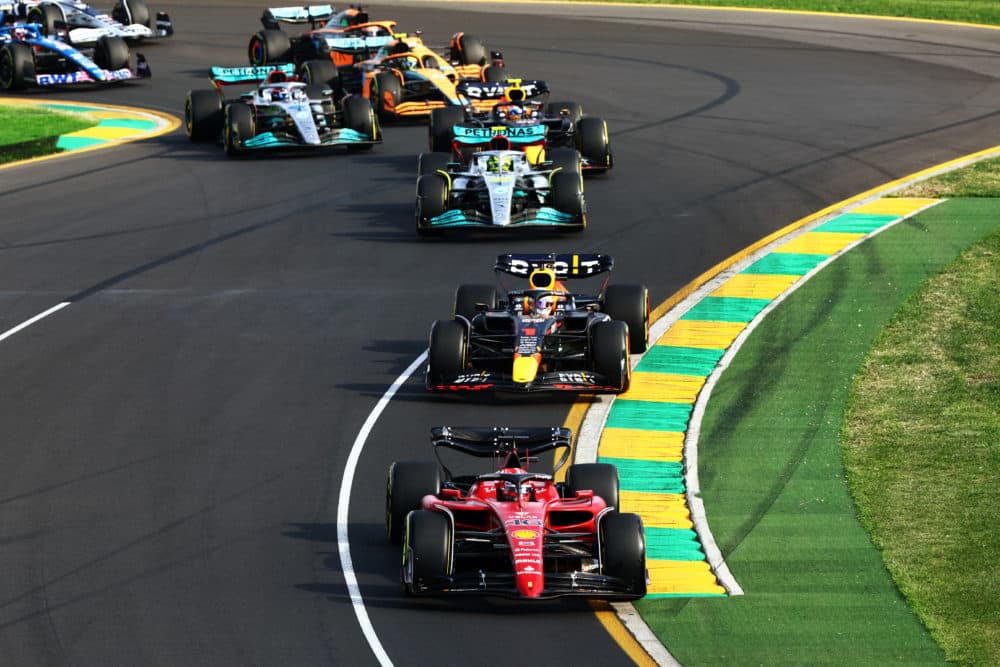Advertisement
The algorithms behind America’s growing infatuation with Formula One racing
Resume
Reporter Byrd Pinkerton remembers the first time she watched the Netflix docuseries Formula One: Drive to Survive.
"We were literally watching the Grand Prix this morning," Pinkerton says. "And I was like, ‘Time to get into tiny men doing hour-long car commercials.’"
F1 viewership in America has hit record highs since the launch of the Netflix series. Because that is what the series was created to do.
Today, On Point: How audience data and Netflix algorithms turned you into the F1 fan you never knew you were.
Guests
Drew Lawrence, freelance reporter who’s written for Sports Illustrated, The Guardian and other major publications. Working on an upcoming F1 podcast for The Red Bulletin, magazine published by Red Bull Media House. (@by_drew)
Carlos Serra, chief operating officer at Audiense, an audience intelligence and social media analysis company. (@serrita22)
Interview Highlights
On the rise of F1 viewership in the United States
Drew Lawrence: “Under new American management, the sport has managed to tap into that very thing that we Americans love so much. And that is sort of soapy reality-style drama, which is our national love language. And they've been able to take what is a very sort of stem-focused, nerds, just sort of mechanically-driven nerd sport and push it through, sort of like the Bravo lifetime filter of personalities, politics, drama. And sort of a stewing rivalry. And allow us as sort of newcomers, sort of casual viewers to really connect with the people and the personalities at the center of the sport.”
F1 was sort of languishing in popularity in the United States. But F1 and all the brands associated with it really wanted to grow in the U.S. Is that where all this begins?
Drew Lawrence: “The turning point is 2007, when the sport changes hand from the aforementioned Bernie Ecclestone, a British lifer who had controlled the sport for decades, to Liberty Media Group, this Colorado-based communications company that owns the Braves, Sirius Satellite Radio. And they really made a priority of giving the sport a foothold in the United States. And the first part of that plan was simply sort of freeing up a lot of that content that Bernie had kept under lock and key, sort of like the behind the scenes stuff, but also the social stuff which is the echo chamber that the sport needs to grow.
"And then the second part of it was sort of casting about and commissioning this idea that they had for a behind-the-scenes series. And as I understand it, they were sort of already ahead on developing something with Netflix. Box To Box, the company that actually makes it and also made the brilliant documentary Senna back in 2010, was in discussions with Red Bull about doing something just about Red Bull.
"And they said, Hey, you should really talk to Liberty because they're trying to develop something like that, but with involving the whole series. So those efforts just combined and then you got Drive to Survive. But it's really this American led group ... that understands the sensibility of its local audience and really pushing to develop something that connected with them. Because they knew they had a good product. They just needed to bridge the gap between it and us.”
On Netflix audience intelligence
Carlos Serra: “Two things. One, if you are already Netflix and you're a subscriber, the way you are watching the shows, going back, stopping, pausing, skipping episodes. Combined with the understanding of what those titles, they represent in terms of gender and different characteristics that they assign to it, actors, etc. All of that creates a massive amount of data within Netflix to understand.
“And somewhere, I think that made that comparison, that other shows, that they are full of drama and they can be the same as this one, that it's full of drama, even if it's nothing to the one with the other. That's one thing.
"The other thing is, if you know that overall and today you tweet about this show, and the first thing you get is an Indy Car fan criticizing the F1 as just giving laps in a boring way. If you know that taking a show in the U.S., you're not going to win with a pure car enthusiast and the pure motor racing fan. You need to find those audiences that they are your target to grow. And if you decided that that was younger audiences, and you started to look at them the same way that they look at people within Netflix, which is how people watch shows.
“Now, when we look at the rest of the world, we try to not segment by demographic. So it's not just about the younger generations, or getting more females involved. You start looking at how they consume, how they get influenced, and you get combinations of that. So you do something called data-clustering segmentation based on how they are consuming media, how they are consuming and being influenced by influencers, personalities, brands, retailers.
"And you end up with these clusters where one of them might be gamers, which was one of their segments they started to attract. And now I'm going to stay at that segment. Because it's not only who the audience was that you wanted to attract, but as well how they behave online."
On the future of sport docuseries'
Carlos Serra: “I think it's already there. One of the new ways that here, at least in Europe, the young generations are engaging with soccer, as we call it in the U.S. It's via this type of content. It's quite interesting. Soccer is a global game, in Europe it's massive. However, we are struggling to drag the younger demographics and the females to watch soccer. The same problem that you have in the U.S. potentially with everyone, and actually across the world. Well, a new way of consumption. That consumption has two elements, particularly one would be this type of documentary, if you want to call it.
"I would say it's different type of summary, exciting summary of a particular sport that touches upon the personalities, the drama, saying everything that is happening. And people love it and that's a way of consuming it, is having eyeballs on the sport, even if they don't like the sport itself. Remember, it's not about the sport. And the second thing which we haven't touched upon, and I think it's quite important, is channels like Twitch, like TikTok, where you still can consume the content as well. It's not just a documentary. And that's another way to connect with those audiences."
Related Reading
The Guardian: "No wonder Netflix is bleeding subscribers – it’s become the new cable" — "After years of exponential growth, Netflix reported on Tuesday that it had lost subscribers for the first time in more than a decade."
Audiense: "The Netflix Effect: How an F1 Docuseries Set Off a Meteoric Rise in Popularity in the US" — "Averaging 946,000 viewers per race, the 2021 Formula 1, also known as F1, viewership was up a phenomenal 41% compared to the 2019 racing season and 56% compared to 2020."
Vox: "I didn’t watch any sports. Then I watched Netflix’s Drive to Survive." — "Four months ago, I started watching Formula 1: Drive to Survive, a Netflix series about car racing with a hilariously high-octane name. It changed my life."
This program aired on April 29, 2022.

